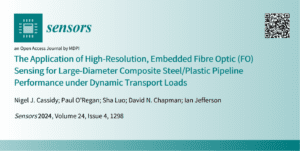New Research highlights a novel approach to buried pipeline condition monitoring
As part of the SmartSense Innovation programme, Aquaspira has published their most recent research in the Journal ‘Sensors’ titled “The Application of High-Resolution, Embedded Fibre Optic (FO) Sensing for Large-Diameter Composite Steel/Plastic Pipeline Performance under Dynamic Transport Loads”. The two-year, InnovateUK funded research programme has developed novel embedded pipeline sensing methods that can be deployed across a wide range of drainage and water management applications including rail, road, housing, and industrial/retail parks. The paper introduces a new hot-weld embedment technique for the installation of fibre-optic (FO) strain sensors that improves on the reliability, robustness and sensitivity of conventional adhesive fixing approaches. The new FO-based sensing system was tested in a full-scale trial where a 4m long, 1.8m diameter buried pipeline structure was subjected to over 10,000 cycles of repeated 11-tonne dynamic loads. Importantly, the findings show that not only is the new embedment approach capable of providing accurate, reliable and high-resolution measurements of strain across the buried pipe, but also that dynamic changes in loading can be picked up by monitoring the system in real time.
Dr Paul O’Regan, Technical Director of Aquaspira and co-author of the research, believes that the new monitoring approach will have a profound impact on the way that drainage systems are utilised across transport infrastructure. Reflecting on the findings of the research he said,
“The application of smart sensing systems in pipelines represents an evolution of our understanding of how buried infrastructure behaves and will, ultimately, lead to improvements in the long-term operational cost and performance monitoring of underground assets”.
Adding…
“This year’s extreme weather events have highlighted the need for different approaches to transport infrastructure management – as recently identified by Network Rail. The ability to measure the dynamic strains exerted on drainage pipelines by external loads, at high-precision and in real-time, opens up the possibility of the pipeline acting as a wider condition monitoring tool. SmartSense, and its ability to pick up subtle changes in the stress-strain conditions around a pipe, means that the train track and surrounding soil are all captured within the monitoring data. This allows for ground movements to be detected before they become an operational issue – slope stability for instance. This type of ‘forward-looking’ data capability can provide the key information needed for predictive maintenance and track safety programmes”.
The paper is part of Aquaspira’s commitment to research and innovation in the sector and we welcome comments from end-users, drainage engineers and infrastructure asset owners. Please contact us at info@aquaspira.com and we would be delighted to discuss how the SmartSense approach could benefit your own operations.


